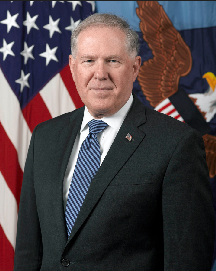
[Satnews] Everyone agrees the United States depends on space-based assets as part of the defense of the homeland and the ability to command and control forces worldwide, Air Force Secretary Deborah Lee James told the Senate Armed Services Committee on the morning of January 27.

Ms. Deborah Lee James was sworn in as Secretary of the Air Force on Dec. 20, 2013. As the 23rd Secretary of the Air Force she is responsible for the affairs of the Department of the Air Force, including the organizing, training, equipping and providing for the welfare of its more than 690,000 active duty, Guard, Reserve and civilian Airmen and their families. She also oversees the Air Force's annual budget of more than $110 billion.
What’s at issue is launching these critical capabilities into orbit using Russian-made RD-180 rocket engines, she said.
The United Nations imposed sanctions against Russia last year for its actions in Ukraine and James and Frank Kendall, the defense undersecretary for acquisition, technology and logistics, testified before the committee on DoD efforts to encourage commercial providers to develop systems not reliant on Russian products.
“Space is key to projecting credible and effective power around the world to support our allies and deter aggression,” James said. “Maintaining our advantage requires the ability to modernize and replenish our space architecture through a reliable launch capability.”
By law, this so-called “short access” to space must be provided by commercial companies. Right now, that requires having access to “about 18 RD-180” engines used in the first stage of the U.S. Atlas 5 rocket, James said.
However, the Air Force is looking beyond the Russian rockets and is encouraging commercial companies to create a new generation of innovation in launch capabilities. “We’re optimistic about these new commercial entrants and have contributed our time, resources, energy and expertise to help develop their systems, understand needs, certify them for government applications, learn from their failures, and celebrate their successes,” she said.
No Alternative Yet
But while there is hope in the future, there is no alternative to the Russian rockets. “We must keep in mind the only launch vehicles that can reach the full range of orbit and carry our heaviest payloads today, remain the Atlas and Delta families,” James said.
United Launch Alliance builds and flies the Atlas and Delta for the U.S. government and other commercial customers. The company enjoys an unprecedented record of successful launches, 90 of which were accomplished under the Evolved Expendable Launch Vehicle program, the secretary said.
“Funding for these government-mandated mission assurance requirements, along with the costs of maintaining launch infrastructure and a skilled workforce, came through a contract vehicle with the government known as the [Evolved Expendable Launch Vehicle] launch capability arrangement, otherwise known as the ELC,” she said.
The Air Force wants to get away from this type of deal. “DoD must look for ways to meet the mandate of at least two commercially viable launch vehicles or family of launch vehicles capable of launching national security payloads,” she said. “In a global launch environment, commercial viability is all about cost.”
Public-Private Partnership
The answer appears to be a public-private partnership as the best way to ensure access to at least two domestic launch service providers, James said. “This business model I want to say again is a better deal for the taxpayer because it uses to a degree other people's money to help eliminate our dependency on the RD-180,” she said. “And our [fiscal year] 2017 budget requests will reflect this approach.”
The next budget request would ensure the availability of a complete launch system through public-private partnerships, she said, with launches of the new system set for fiscal 2022 or 2023. “We believe this is the best approach to achieve our mandate of assured access to space with two certified, commercially competitive domestic launch providers,” she said.
She asked the senators to remove language in the fiscal 2016 budget that restricts the use of these funds to engine development alone so the service can shift to the complete launch system.
“So far, of the $260 million authorized and appropriated… we have obligated just over $176 million,” she said. “The balance will be obligated soon pending of course successful outcome on negotiations with industry.”
At the same Senate Armed Services Committee meeting, the undersecretary of defense for acquisition, technology and logistics described a novel concept to acquire access to space during his testimony to the Senate Armed Services Committee today.

Frank Kendall, the undersecretary of defense for acquisition, technology and logistics.
Frank Kendall told the committee that the proposed acquisition strategy will prepare the Defense Department for the future in space as well as driving down costs. And, he said, it will be an American solution—one not reliant on Russian-made RD-180 rockets as is today’s Atlas 5 system.
Kendall’s solution would not replace one Russian-made rocket with an American counterpart, he explained. He is looking to meet DoD’s priorities of short access to space with at least two affordable and reliable sources of launch services. This will ensure competition, which should drive down costs and end any use of the RD-180 Russian engine for DoD launches, the undersecretary said.
“The first thing I would like to emphasize is that the department does not buy rockets or engines. We do not buy launch systems or propulsion systems,” he told the senators. “What we do buy is the transportation of our satellites to space by launch service providers.”
Given Russia’s actions in Ukraine, the United States would like to stop using the Russian RD-180 engine. “The obvious and direct thing for the department to do would seem to be to pay for a new engine to replace the RD-180,” he said. “There are three problems with this.”
Challenges
The first is that engines are designed for a specific rocket and are not interchangeable, Kendall said. If the U.S. government decided to build a copy of the RD-180, it would only fit on the Atlas rocket and would benefit only one company—United Launch Alliance, the undersecretary said.
“Second, this would be expensive,” he said. “Current estimates are that this would take about $3 billion.”
Finally, Kendall explained, DoD doesn’t need an engine; it needs reliable, affordable and efficient access to space through commercial companies.
“The commercial space launch business and space as an operational domain are both in transition,” he said. “A number of commercial enterprises are planning large-scale constellations involving hundreds or even thousands of satellites.”
Capitalize on Commercial Investments
Given this, DoD should be able to take advantage of the economies of scale, Kendall said. “This potential market is motivating launch service companies, like SpaceX, ULA and others to invest in more modern and efficient space launch systems,” he said. “The department does not need to and should not carry all the cost of developing more efficient space launch systems. We need to capitalize on these commercial investments."
But, he noted, DoD has additional concerns and requirements than purely commercial companies. “The department is concerned about the ongoing foreign military acquisition of anti-satellite systems by countries like Russia and China,” Kendall said. “This development is causing a major rethinking of our space system designs, with a resiliency to possible attack now a much more important operational and technical consideration.”
One approach is to replace the small number of existing highly capable satellites with a larger number of satellites with more distributed capabilities. “This development also suggests the need for more efficient launch service providers to fill those constellations,” the undersecretary said.
All this combines to give DoD the opportunity to enter business arrangements with prospective launch service providers using a commercial model, Kendall said.
“The basic business deal we have in mind is that the department will, through competition, provide at least two launch service providers with some of the capital they need to develop, test and certify the launch systems they will use to provide us with launch services in the future, including any unique DoD requirements,” he said.
In return, Kendall said, DoD will acquire the right to purchase launch services in the future at competitive prices and some degree of assurance that those systems will actually be available.
The exact form of these business arrangements will be dependent on the unique needs of each competing prospective launch service provider, he said. “The department has received industry responses to formal requests for information … which tell us that this concept has a real chance of success,” the undersecretary said.
Requests for Proposals
Kendall told the committee that the department will release a draft request for proposals shortly, in hopes that the final requests will be released by the end of the year. DoD hopes to award contracts in fiscal 2017, he said.
“In most acquisition strategies, the department specifies the product or service that it desires and industry bids to provide the specified deliverables,” the undersecretary said. “In this case, industry will have an important role in defining the terms of the arrangement or contract. Each selected launch service provider is expected to offer unique terms that will have to be negotiated.”
Kendall said that some factors to be weighed in awarding any contract will include “the technical risk of completing the launch system and achieving certification, the schedule to provide launch services without Russian engines, the soundness of the business case to provide commercial launch services officially, the cost of any not to exceed future launch service options for DoD and of course the amount and timing of DoD funding needed to complete development and certification of the proposed launch system.”
The undersecretary asked the committee to support this approach. “We are anxious to move forward so that we can end the use of the RD-180 and take advantage of the emerging commercial space launch service market,” he said.
Article by Jim Garamone

